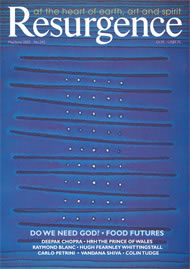Jonathan Newdick’s father worked the land. The construction of the phrase is important. He worked the land, not on the land. The one suggests a relationship, the other a trampling. Newdick himself works the land but he is not the smallholder that his father was.
He has lived almost all his life in rural West Sussex and knows and loves its chalk and its clays, its grey seas; all of which have become part of his psyche so that when he makes a drawing it is as if the land is drawing itself. He, the artist, is the medium through which the drawing is made. Newdick feels that he does not make drawings of things: he makes drawings about things.
What makes Newdick particularly interesting and unusual is his instinctual connection with the elements, mainly with the Earth. The planet. His landscapes tell of tellurian power. When you look at them you are driven into an unknown dimension.
The Earth is a very little-known dimension. Yes, we know all her scientific constructions but, since we lack the wisdom and the intuitive nature of our forbears, her feelings are unknown to us. Or, if they are known, we don’t acknowledge them. At times the Earth is tender, at other times she is angry and the usual pictorial depictions of these emotive states are based upon her surfaces – we have forgotten how to see inside her. I have learned a lot of the spiritual signs of the Earth by watching Newdick’s drawings grow, because he is one of the few who can give voice to those forgotten feelings.
When he works a drawing in black and white he uses literally metres of graphite, much of which will end up on the studio floor by the sometimes frenzied action of the eraser. As he works, the time-space dimension expands and something happens, as if the gates come open and the Earth talks to him. It is a timeless dialogue.
HIS RECENT WORKS are very much commentaries on contemporary technologies. They are inspired by the acres of opalescent synthetic fleece that cover the salad crops surrounding his studio. This is global agriculture on an industrial scale and yet the unexpected image of a ‘sea’ shimmering in the middle of the English countryside is, at first, extraordinary. Beautiful even. It does not meet with his approval, but it clearly represents the contradictions of our times: on those very fields, not many decades ago, horses pulled the ploughs. To discuss it he has devised a new way of working. He calls it graphite transfer. It involves making drawings and writing notes in the fields and then, in the studio, making a full-sized drawing in graphite on polyester film. This may be anything up to a couple of metres across. When he is satisfied with this drawing it will, in effect, be destroyed for he now turns it over onto a large sheet of white paper and re-makes the drawing on the back of the film. The pressure from this second drawing transfers the image of the first one onto the paper, altering it in the process. This gives the final result the qualities of line and texture that would be impossible to achieve with direct drawing.
His graphite transfers are black and white and the black is very black. The black of his wild landscapes connects me with the depth and darkness of the inside of the Earth which hides colours of untold beauty. The most precious stones of the purest light are hidden in the dark womb of the Earth. Waves of colours come from that darkness and Newdick acknowledges them, because his transfers reveal a subtle infinity of colours.
Black and white can give us a sense of dualism, perhaps because we are held in a concept where black is negative and white is positive and we make no effort to go beyond it. For Newdick black is certainly not a ‘negative’ colour. Ink is black, he says, and it stands out on the white page: it allows us to see, to read, to know. Newdick is spontaneously wandering in a field of complementary meanings.
Newdick has written of his need to become the land he walks on, not through death but through life, and on the evidence of these works he has found the way to achieve his aim.
An exhibition of Jonathan Newdick’s work will take place from 5th July to 4th of August 2007 at Queen Street Gallery, The Old Flour Mill, Emsworth, Hampshire PO10 7BT. Jonathan will show a book he wrote some time ago, but mainly his new acrylic landscapes as a further investigation of the "Salad Fields" which are featured in the above article.
The Gallery is open Tuesday to Saturday 10.00am to 4.00pm
Telephone: 01243 372 722 Mobile: 07930 932 986







